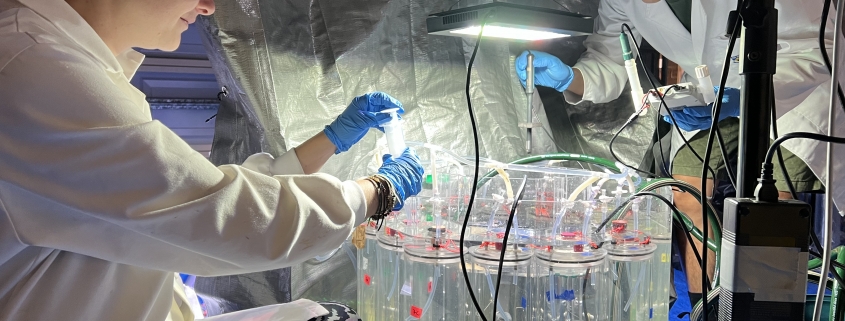Sediment samples at the core of a model project
Dozens of core samples, taken from sediment around Cockburn Sound, will play a crucial role in the creation of a model of the area’s ecosystem to help inform environmental assessment of the proposed port.
The work, being done as part of the WAMSI Westport Marine Science Program, involved divers collecting three sediment cores from 12 sites and scientists analysing them at a specially created laboratory nearby.
The project is being run by Professor Bradley Eyre from Southern Cross University and Professor Matthew Hipsey, from The University of Western Australia.
Professor Eyre said the tubes of sediment and water were set up in a laboratory, in the garage of a beachside home, where conditions simulated in situ temperature and changing light conditions between night and day, at the sediment surface.
“Some analysis is best done when we have fresh samples, so we wanted to avoid any delays,” Professor Eyre said.
“Other samples will be sent back to the Southern Cross University campus near Byron Bay, which has the only instrumentation in Australia for some of the analyses.”
The 12 locations in the Sound, represent different types of shallow and deep sediments including muds, seagrass meadows, and sandy areas.
“In the laboratory, we were measuring the flux of oxygen and nutrients in and out of sediment including nutrients such as ammonia and phosphate,” Professor Eyre said
“Some of the tubes contained sediment with seagrass growing in it.
“We are also measuring a critical process in the sediments called denitrification.
“Denitrification is a natural process by which ecosystems such as Cockburn Sound can remove nitrogen.”
“It is a really important cleansing process but if the carbon load gets too high the process can be reduced.”
The researchers said data from the sediment testing would underpin new water quality modelling of the Cockburn Sound ecosystem.
“The data complements other key experimental data being collected as part of the WAMSI Westport Marine Science Program on the chemical and biological conditions, allowing the development of Cockburn Sound Integrated Ecosystem Model platform to help manage the system,” Professor Hipsey said
“What we are measuring will reflect what is happening currently in the Sound and when used alongside the modelling we will be able to predict what will happen under future scenarios.”

